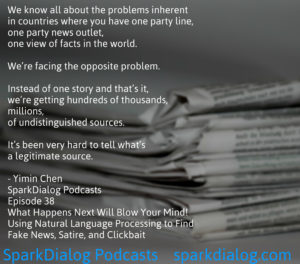Podcast: Play in new window | Download
Subscribe: Apple Podcasts | RSS | More
Where do you get your news from? Can you trust it? Gone are the days when most people read the newspaper. Instead, many people now get their news from their Facebook feed, Twitter, or a host of other online sources. Unfortunately, amid the cat videos and photos of friends, it may be hard to tell the difference between a legitimate news source and fake news or satire. And then there is click-bait. Sensational news headlines sells. This allows websites to make more money on ads, independent of the quality of the news that they broadcast. 
But with natural language processing, we may be able to develop a way to identify all sorts of “fake news”, ranging from falsified news to omissions to satire to click-bait. On today’s podcast, we talk to Dr. Victoria Rubin. Victoria is an Associate Professor at Western University at the Faculty of Information & Media Studies, and specializes in using natural language processing techniques to identify patterns in text. She is joined by her four doctoral students. Yimin Chen studies internet trolls and trolling, and finds ways to identify satire, clickbait, and other misleading content on the web. Sarah Cornwell works on native ads, satire, and click-bait. Toluwase Asubiaro specializes in informetrics, natural language processing, information retrieval, and automatic language identification. Finally, Chris Brogly is developing a news verification browser.
You can find out more about Victoria, her group, and their work on Twitter @VictoriaRubin.

One thought on “Ep 38: What Happens Next Will Blow Your Mind! Using Natural Language Processing to Find Fake News, Satire, and Clickbait – with guests Dr. Victoria Rubin and her Group”